| 1 | Brown watersnake |
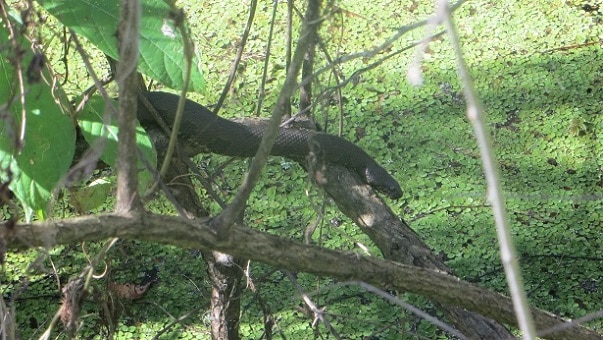
The browner, more southerly relative of the northern watersnake. This species lives in Louisiana, Georgia and Florida and eats 100% fish, 60% being catfish. Brown watersnakes are infamous for resting on branches overhanging lakes, sometimes over a fisherman’s head. They’re equally notorious for jumping off those branches when startled. This is said to be to attack people, but it’s actually to flee, and the brown watersnake can disappear instantly, as their first move is to dive below a lake surface. They have an advanced breathing apparatus, and can stay below for 30 minutes, surfacing occasionally for a breath.
A brown watersnake can disappear in 1-2 seconds after dropping off its branch. If they do land on your head, there’s nothing to fear, as this is a non-venomous species, which also has a calmer personality than the northern relative.
Brown watersnakes are common in the southern USA, particularly in swamps and lake shores. Because they disappear so fast, it’s hard to get close enough for a decent look. Your best bet is when they’re on the shore, and unable to drop off a branch and instantly vanish into the watery depths.
| 2 | California whipsnake |
California whipsnakes not only disappear instantly when threatened, but choose their habitats specifically so that they can. This is an ultra thin snake measuring 120cm, which is non-venomous and mainly hunts reptiles such as western fence lizards, alligator lizards, and western skinks.
California whipsnakes can be extremely calm if picked up. You can walk right over to one on a dirt track and grab it in the palm of your hands. They don’t bother to bite or thrash, but stare ahead blankly. When you get bored, and place it back on the dirt track, the California whipsnake will blast off and disappear into the undergrowth in milliseconds.
The California whipsnake’s favourite habitat is chaparral or coastal scrub, intermingled with rocky areas with cracks they can disappear into. These bushy habitats are perfect for protection from birds, their main predators. California whipsnakes are one of the quickest snakes in the USA, alongside coachwhips. They move at a speed a boa constrictor could never dream of. If you turn your head to joke with a friend, the California whipsnake could be gone when you turn back.
| 3 | Orange-bellied swamp snake |
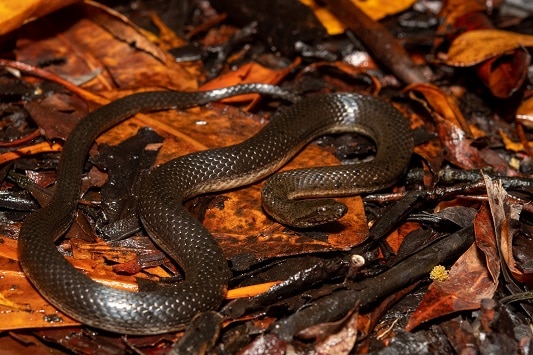
A swamp dweller of Central America. Orange-bellied swamps snakes measure 60cm and stay in their swamps most of the day. Their default position is a submerged body and a brown head raised up, scanning the shore for any sign of movement.
With Tretanorhinus nigroluteus, it’s debatable whether you’d even notice them in the first place, as they’re so well concealed in swampside reeds. But if you do, then a glimpse is all you’ll get, as this snake’s first response is to instantly duck below the water. They only have to duck their head down 15cm and then they’re gone, leaving you questioning your sanity again. Orange-bellied swamp snakes probably won’t reappear until they sense that you’ve left the vicinity, so your only choice is to return the next day for round 2.
Disappearing quickly is essential for this snake’s survival, as herons and egrets are always searching for them, searching for a snack. Orange-bellied swamp snakes can be found in Nicaragua, Honduras and Costa Rica. They’re harmless to humans, with no known venom.
| 4 | Zebra spitting cobra |
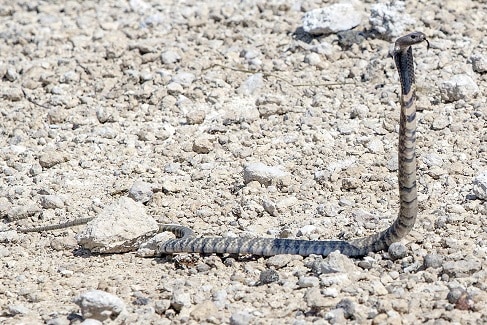
This spitting cobra has a small, tidy range, inhabiting Namibia and Angola. It was originally part of the black spitting cobra, but separated into a full species in 2007 because of its vivid black-white stripes. Naja nigricinctus prowls dry plains, yet can vanish in an instant. One blink and they could be gone, leaving you wondering whether you’ve seen a mirage.
Zebra spitting cobras have excellent instincts for finding mammal burrows and dark rock cracks to hide in. They particularly love the latter, and disappear into them for hours when the day’s hunting is complete. Poking your head into a dark rock crack is very dangerous in Namibia; you could easily receive an eyeful of venom, which can blind if it isn’t washed out with a water bottle instantly. Coupled with a fast, agile nature, zebra spitting cobras are experts at constantly disappearing.
It’s hard to predict a zebra spitting cobra’s next move. They won’t charge at anyone that strays close, but can be extremely aggressive, and will rear up in their signature warning hood. In other cases, they flee instantly. Never stray to within 5 metres, as its spat venom is exceptionally accurate. The zebra spitting cobra reaches lengths of 1.5m.
| 5 | Common bronzeback |
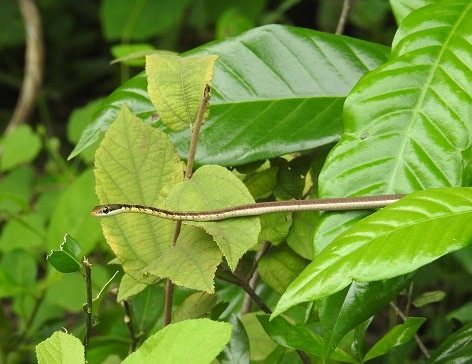
This species is found in Sri Lanka and most of India, plus Nepal and Myanmar. This is one of India’s harmless snakes, no threat to farmer nor postman. The problem is that they’re also no threat to predators, so instead, the common bronzeback relies on a rapid escape. They’re a fast and agile snake which likes forests, but also sparser woodlands and town gardens. There’s always undergrowth for them to flee into, and that’s what they do, disappearing instantly, perhaps never to be seen again.
The annoying part is that their camouflage is also excellent, so you might think you’ve lost sight of them and scan around in frustration. In reality, they’ve been gone for minutes. Common bronzebacks prey on lizards and frogs. Like most of our list, this is a thin snake, yet reaching decent lengths of 100cm, maximum 169cm. Less bulk makes it easier for them to speed off like a limo at traffic lights.
Bronzeback snakes are manifold in southeast Asia, but this version is separated by a light spot on its head, just above the neck. In Thailand, painted bronzebacks (Dendrelaphis pictus) are most common, but Dendrelaphis tristis rules in India. Electric blue scales on the flanks are also a way to identify them.
| 6 | Forest flame snake |
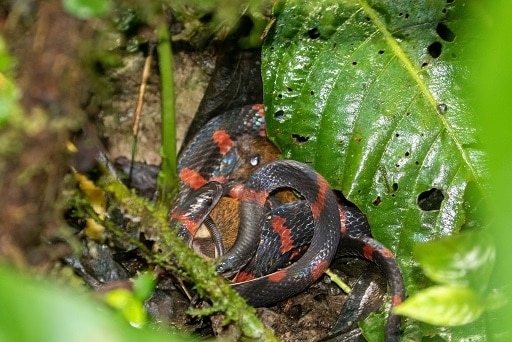
A snake of Central American forests, which is always skirting over bushes, annoying agricultural workers. When confronted, this snake vanishes into the bushes instantly, until the next day when it reappears as though nothing happened. This is referenced in the forest flame snake’s Latin name: Oxyrhopus petolarius. Oxys means “quick” in Greek, while “rhops” translates to bush, their favourite place to flee into.
This snake is no threat to human beings at all. Their venom is not only mild, but specialised against reptiles like yellow-tongued anoles. Forest flame snakes aren’t difficult to find, inhabiting rainforests and cloud forests. They’re difficult to maintain though – photographing one is a nightmare when they flee the very second they notice you.
Forest flame snakes measure 50-100cm and would always flee rather than confront a predator. Their forest habitats make this possible. They might still be a few meters away, waiting until the coast is clear, yet completely invisible and out of sight. The forest flame snake is no fool: given how many predators the rainforests of Costa Rica have, disappearing instantly is just as wise as having a horrifying venom, if not wiser.
| 7 | Short-snouted grass snake |
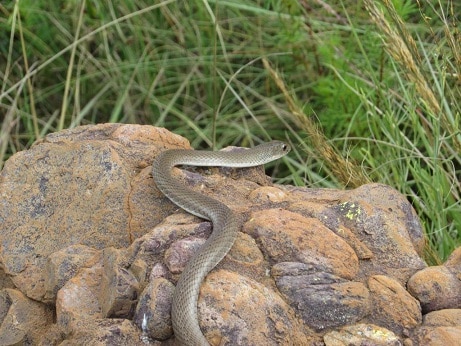
A harmless species of South Africa, Zimbabwe and Mozambique. Psammophis brevirostris is very common and appears in villages and grasslands alike. Southern Africa is full of cunning predators, and the short-snouted grass snake’s first response is a piercing hiss.
They stand their ground, inhale a large gulp of air (which visibly swells their chest) and expel it with all the intimidating menace they can muster. But some predators are so hungry that they don’t care, and the short-snouted grass snake then activates its second strategy: disappearing instantly. Like all Psammophis members, they’re very fast and can vanish into tall grass clumps in a flash. Being very thin, they can vanish into undergrowth that a hyena is too bulky to access. The snake is gone, and seconds later, it dawns on the hyena: its prey has escaped.
Short-snouted grass snakes measure 40-60cm, occasionally becoming far longer at 1.2 metres. They dine on skink lizards and will bite humans if gripped, preventing them from escaping. Short-snouted grass snakes are small enough that they can vanish at will (unlike a giraffe), and they use these powers to their fullest.
| 8 | Steppe ratsnake |
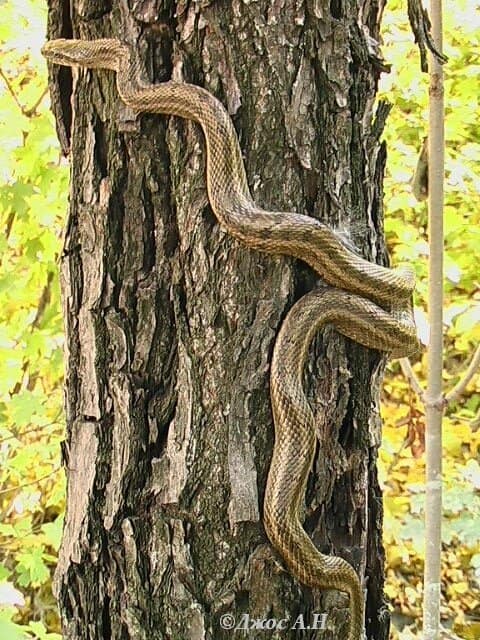
An incredibly widespread species, ranging from southern Ukraine to China. This is a species of open territories like grassland where they’re highly vulnerable to birds. To compensate, they’ve developed the skill of disappearing like a ghost.
In 2022, this was the focus of a study, in China’s Red-Crowned Crane Park. This reserve is a bird-watching paradise, with an abundance of its namesake crane species. Steppe ratsnakes were also common, and it found that they deliberately basked in the sun in close proximity to cracks in concrete wall or bricks. Steppe ratsnakes were quick to notice birds approaching, and equally quick to vanish into their hideyholes. According to the scientists: “When E. dione noticed a predator approaching, they rapidly move in these hiding sites“.
The study followed 20 steppe ratsnakes in total. They actually preferred this tourist heavy area to an adjacent natural landscape (Xianghai natural reserve), because there were so many opportunities to vanish. In an untouched wild, steppe ratsnakes vanish into mammal burrows or gaps in tree trunks. This species mainly eats mammals and averages at 60-80cm.
| 9 | Werner’s sipo |
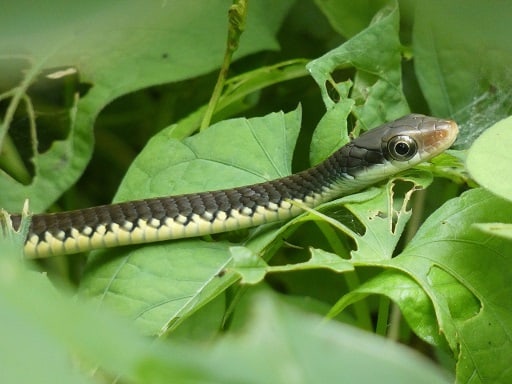
Also known as the yellow-spotted whipsnake, this species lives in Costa Rica, Panama, Colombia and Ecuador. Werner’s sipo inhabits lowland forests, particularly evergreen forests at 0-650 metres above sea level. They prey entirely on frogs, including Smilisca tree frogs.
Though only distantly related, Werner’s sipos (Chironius flavopictus) have a similarly thin body to the California whipsnake, and they disappear just as rapidly. They can vanish into forest undergrowth in milliseconds, as though they were never there. Werner’s sipos normally move at a steady pace, investigating tree trunks, shoving aside leaves with their heads. When spooked, their default is to vanish, and they do it well. Werner’s sipos can reach 203cm and their body is exceedingly thin. Their tail just keeps going until it gradually becomes so thin that it no longer exists.
Chironius snake species (sipos) are plentiful in South America, but this version is identifiable by light spots (normally yellow) against a black background. If you stand next to this snake as it blasts off, you’ll probably receive a painful lash to your leg.
| 10 | Radiated ratsnake |
Though dubbed a ratsnake, this is only a distant cousin of the steppe ratsnake (Elaphe family). Radiated ratsnakes are a staple of Indian farmland and are most closely related to trinket snakes. They’re non-venomous, but tolerate no human incursion whatsoever. Pick them up and they’ll bite savagely with their pupils spinning. Drop them in pain, and they’ll speed away into the undergrowth.
The radiated ratsnake more than outstrips a dog or scurrying rat for speed. They normally prowl around at a steady pace, not being twitchy and caffeinated like a golden tree snake. Yet they always keep a dose of explosive speed in reserve for when they need to flee.
Scientific surveys are a struggle with the radiated ratsnake. This is a hard snake to control at the best of times, and if you drop them just once, they’ll zoom off into the bushes like lightning, never to be seen again. Radiated ratsnakes are very common and range from India to Thailand and Malaysia. Their ability to disappear as long as vegetation is around has allowed them to survive and keep on spreading. This species can reach 230cm and regularly strays to villages.
